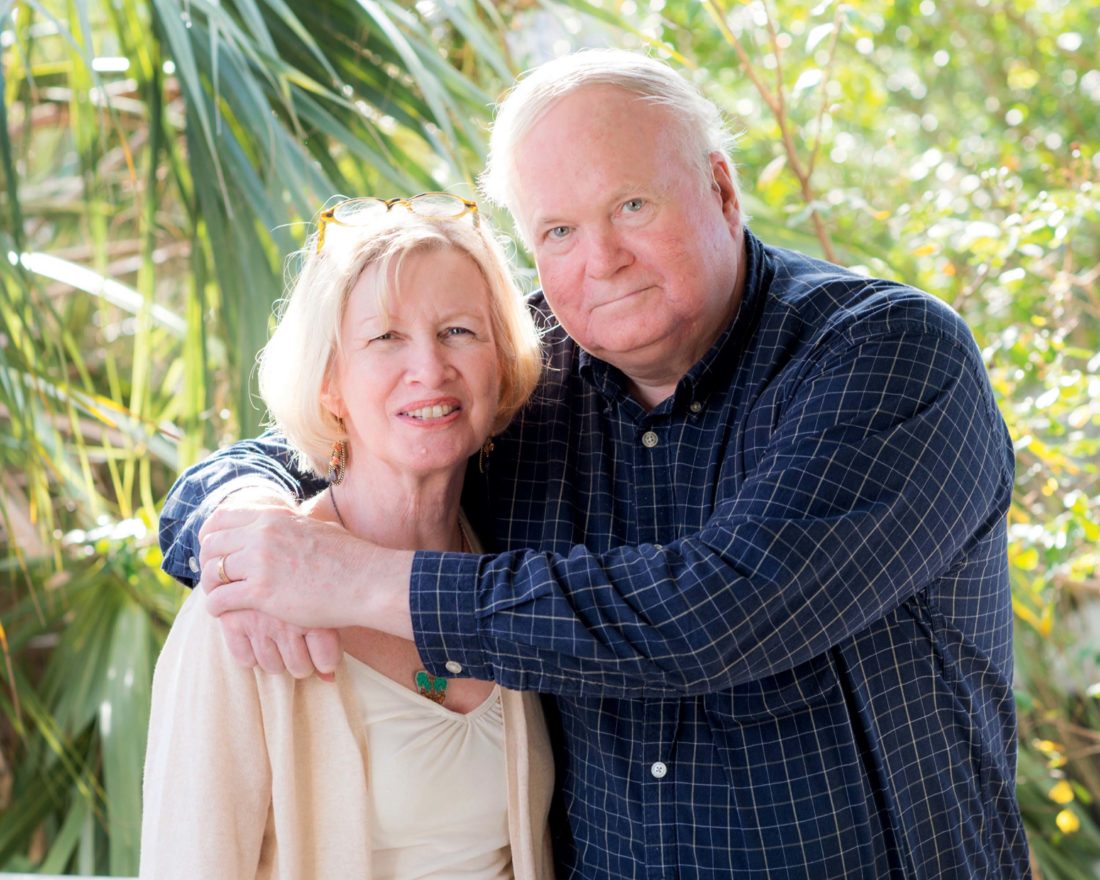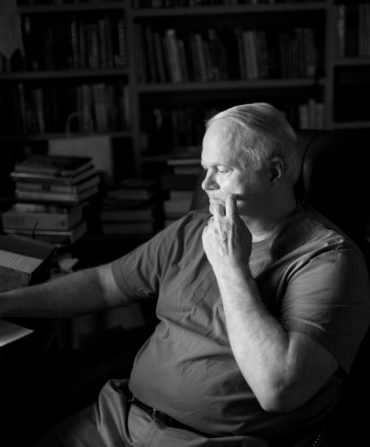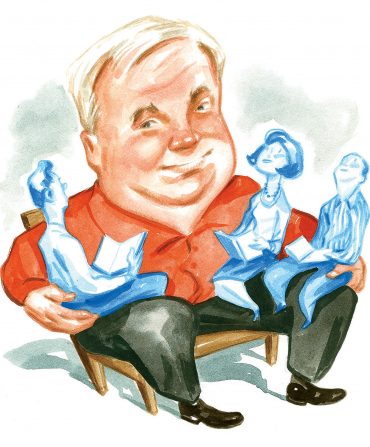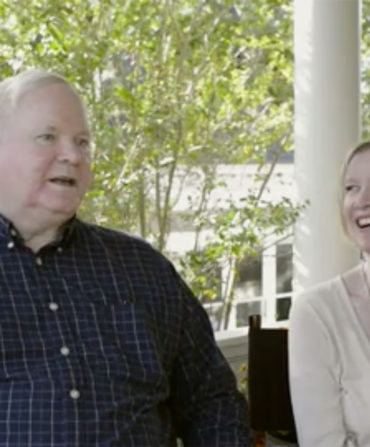We tell stories to remember. And when the author Pat Conroy died in March 2016 of pancreatic cancer, his wife, Cassandra King Conroy, knew there was only one way to channel her grief. “I would go back to writing,” she says. “That would be what I would have to do to go on with my life, without him.”
Cassandra, a Lower Alabama native, had met Pat twenty-one years earlier, and after their friendship blossomed into a long-distance courtship between her home state and Pat’s cottage on Fripp Island, South Carolina, the two married in 1998. The couple eventually made their home along a creek in Beaufort, where Cassandra—the best-selling author of such novels as The Sunday Wife and The Same Sweet Girls—still lives, writes, and serves as the honorary chair of the Pat Conroy Literary Center, which she cofounded.
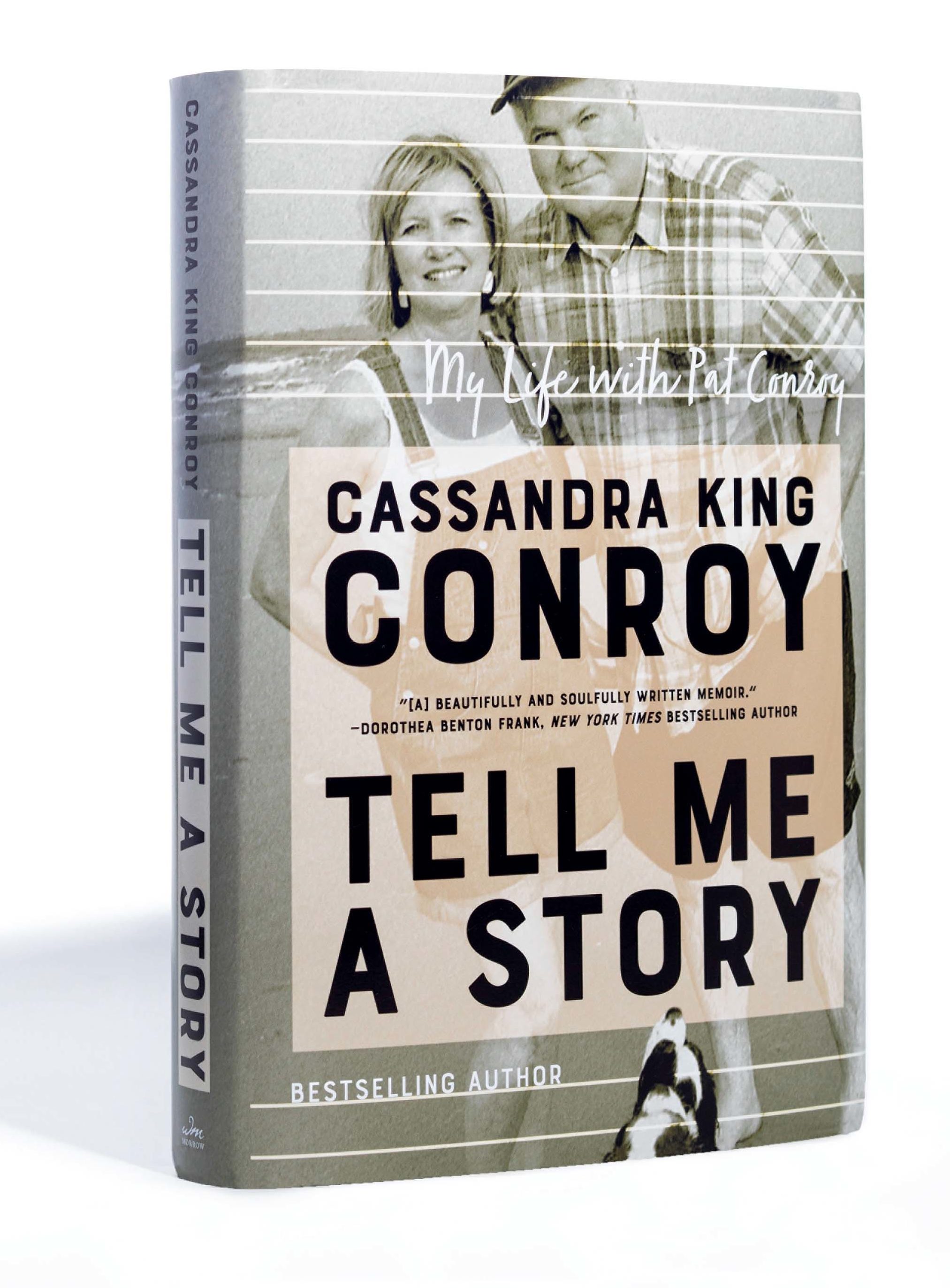
Jacqueline Stofsick
There, in the writing room Pat insisted she have, Cassandra penned Tell Me a Story: My Life with Pat Conroy, a remembrance that spans from the moment they met to the first time she visited Pat’s grave on St. Helena Island. The memoir, which comes out in October and is excerpted below, offers not just an intimate account of what it was like to live with the larger-than-life Pat—whose name became synonymous with the Lowcountry thanks to such beloved books as The Great Santini and The Water Is Wide—but an unvarnished look at marriage, particularly at the heartache and complications that come with blending families.
“Pat laid so much out there for his readers,” Cassandra says, “and that’s not really my style. But on the other hand, I knew that this had to be an honest book, or there was no point in my writing it.”
From Tell Me a Story, by Cassandra King Conroy
It was several days after his father’s funeral when Pat and I ran away to get married. One thing we knew for sure—we didn’t want any hoopla or publicity surrounding our wedding, so we didn’t tell anybody about it. Even I didn’t know about it at first. He was always one for surprises, and it would take me years to learn to read him. Not that I ever did, but it got a little easier as time went by. After I’d come to live with him, I’d written Pat’s daughters and my sons a letter in an attempt to explain our insanity in joining forces at our age and stage in life. I hoped they understood it, I said in the letter, because neither Pat nor I did. Truer words have never been spoken.
It all began one cold evening in February 1995, when I met Pat Conroy at a party in Birmingham, Alabama. He was at the height of success for a writer; after dominating the best-seller list for months, his blockbuster 1986 novel, The Prince of Tides, had been made into a movie with Barbra Streisand and Nick Nolte in 1991, nominated in seven categories at the 1992 Oscars.
If I’d arrived at the party a few minutes later, Pat and I would’ve missed each other altogether. Later, we’d claim that fate brought us together because of the near misses and coincidences of the way it happened. Pat had flown in that afternoon from New York, where he’d been working on the final rewrites of his upcoming book, Beach Music. He’d come to Birmingham to receive an award at a literary conference. He hadn’t wanted to interrupt his editing, had tried to get out of making the trip, but his publicist wouldn’t let him cancel. Tickets had been sold, the program printed.
While Pat had reached the summit all writers dream of, I was just getting started. My first novel, several years in the making, was coming out soon. I was living in Montevallo, Alabama, at the time, a college town thirty-some miles south of Birmingham where I taught composition and worked in the writing center at the college. Like Pat, I wasn’t exactly looking forward to the party, a meet and greet to welcome the visiting writers at the Southern Voices Literary Conference, but for entirely different reasons. I’d always been shy and ill at ease at social occasions, cocktail parties in particular. Standing around making small talk with strangers felt forced and awkward to me.
At the appointed time I picked up one of my closest friends, Loretta Cobb, for the drive to Birmingham. Loretta and I were not only friends but also colleagues, since she directed the writing center where I worked. Her husband, Bill Cobb, had been my mentor and writing professor. Once inside the party, I cornered one of the librarians.
“I’d love to meet Pat Conroy,” I told her. “It’d be great to tell my students about him.” I went on to explain to her how I used examples of his gorgeous prose style in handouts for my freshman classes.
The librarian frowned. “Aw, shoot, honey—you just missed him.” Pat’s father, the Great Santini, had gotten tired, and he had left to take him back to the hotel. “Pat’s so nice and friendly. Everyone on the library staff has fallen in love with him.”
Disappointed, I made a beeline for the refreshment table. Since I’d had nothing to eat since breakfast I was beginning to feel light-headed. Out of the corner of my eye I saw that Loretta and Bill were talking with Jake, a bookseller I’d known for a long time, and a man I didn’t know. Broad shouldered, with ruddy cheeks and a wreath of white hair, the man looked vaguely familiar, but I was too preoccupied with my imminent starvation to wonder why. In rumpled, baggy khakis and a plaid shirt, the stranger was sloppily dressed even for a writer, so I figured him to be a presenter’s spouse who’d been dragged along.
I’d just crammed a whole chocolate-covered strawberry into my mouth when I saw to my dismay that my friends were leading the stranger toward me. To this day, I can’t settle the debate over who actually made the introductions, as each of my friends takes credit for it. All I remember for sure is this: When Loretta said, “Hey, girlfriend, I found Pat Conroy for you,” I choked, swallowed, and coughed before blurting out, “Oh, God Almighty!”
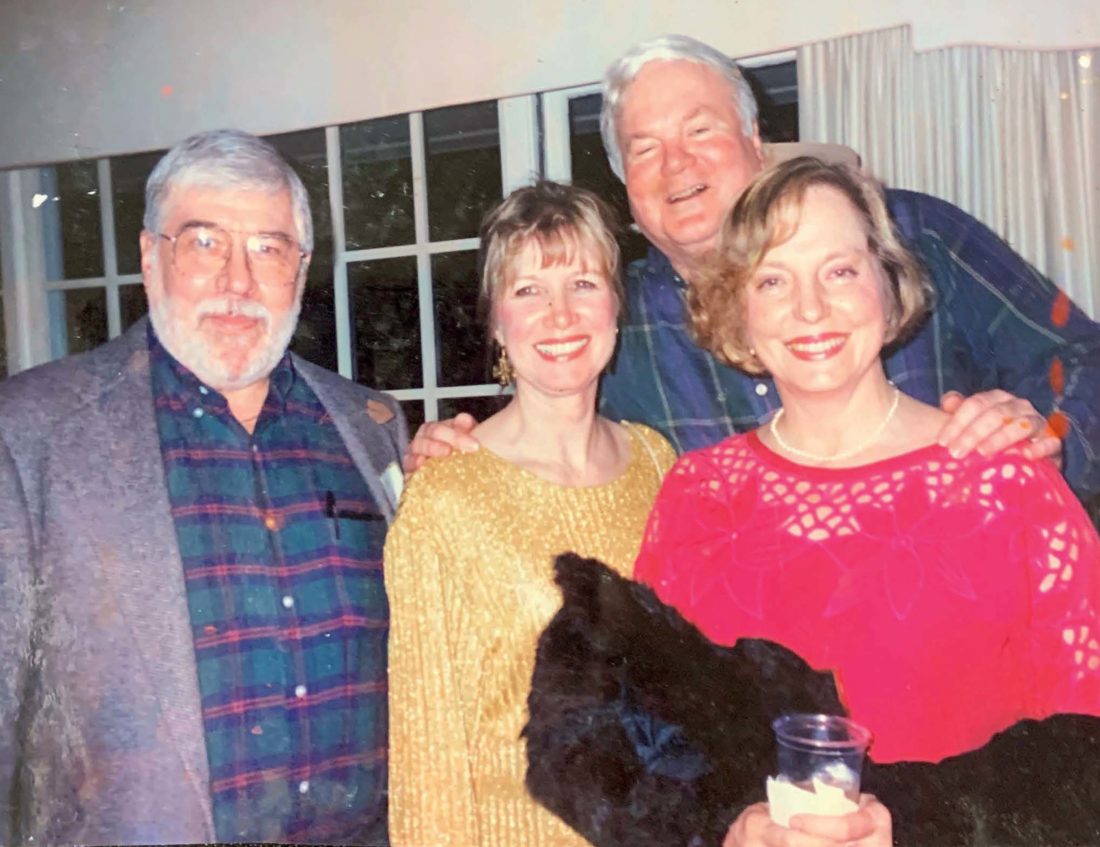
Photo: Courtesy of Cassandra King Conroy
Cassandra and Pat (center) on the night they met, with their friends Bill and Loretta Cobb.
Pat threw his head back and laughed a big, hearty laugh. “Not quite, but close enough.”
“But…you can’t be Pat Conroy,” I cried, flustered. “When I asked about you, they told me that you’d gone to take your father to the hotel.”
Pat shrugged. “Yeah, I was walking out the door when the hostess stopped me. She found someone else to take Dad because she wanted me to make an announcement for her.”
Fate, Pat would later say. That’s how close we came to missing each other.
Nervous now that I was in the presence of the writer I’d most wanted to meet—one I considered to be among the greatest living writers of our time—I began babbling like an idiot. Taking pity on me, Pat motioned toward the table. “I haven’t eaten tonight either. Why don’t you show me what’s good here?”
It was the perfect icebreaker. He gave each thing I pointed to careful consideration, and he’d give me a thumbs-up and reach for another when something pleased him. The first conversation I had with Pat Conroy wasn’t about Proust or Faulkner, or even the other writers at the conference. We talked about food.
Something unexpected occurred over the bruschetta and cheese spread, however; Pat Conroy was so laid-back and friendly that I forgot to be awestruck. We chatted easily, as if we’d known each other all our lives. Which is not to say that being with him wasn’t intimidating. Pat had an imposing and vibrant presence, an aura of magnetism and charm. No doubt part of it was his size. Almost six feet tall, he had the rugged build of a linebacker and shoulders wide as a tree trunk. Although not conventionally good-looking, he was undeniably attractive.
Bill came back over to us. “Since my favorite student’s got you cornered, Pat, I guess she’s telling you about her new book,” Bill said. “Her first novel, and it’s coming out in a few months.”
Grimacing, I tried to motion for Bill to shut his mouth, but it was too late. Pat turned to me in surprise, eyebrows raised.
“Why didn’t you tell me you were a writer?” he demanded. “All this time, I thought you were the caterer or something.”
“I—I’m not!” I stammered, red-faced. “I mean, it’s just a small press. I’m not really a writer—”
Pat waved off my protests with his napkin, as though swatting at an annoying insect. “What’d you mean, you’re not really a writer? That’s the most ridiculous thing I’ve ever heard. You’ve got a book coming out. You wrote it, right? Therefore, you’re a writer.
“Now then,” Pat said, his eyes focused on me like laser beams. “Tell me about your book.”
I started off stammering, not sure where to begin. But Pat helped me along, drawing me out with his questions about my novel. That night was the first time I’d talked to anyone about Making Waves, even Bill, about why I’d been compelled to write the book I’d written.
Our conversation turned to publishing. Pat told me the story of the first writer he’d asked for a blurb, and how the famous author turned him down by saying he couldn’t put his name on such an insignificant work by such an insignificant writer. “I hope you’ve had better luck with your requests,” he said with a chuckle.
I didn’t know many writers, I admitted, but the few I knew had been kind enough to respond favorably to my pleas for blurbs. “But if I’d had your experience,” I told him with a shudder, “I would’ve never gotten up the nerve to ask anyone else.”
Pat studied me a minute then said casually, “Have your publisher send me your book, okay? If I like it, I’ll give you a blurb. If not, I’ll pretend it got lost in the mail.”
Before I could respond, the hostess interrupted our conversation to take our picture together. She then motioned for Bill and Loretta to come over and took one of the four of us, a copy of which Pat and I would later frame as a reminder of our first meeting. The hostess then took Pat’s arm and reminded him of the announcement he’d promised to make for her.
Before he left to fulfill his obligation, Pat and I exchanged phone numbers and addresses so I could send him an advance reading copy of my book. He gave me a warm, friendly hug and said, “It was great meeting you, King-Ray, and I really enjoyed our conversation. I can’t wait to read your book. If I don’t see you at the conference tomorrow, I’ll call you, okay?” He patted the pocket of his plaid shirt where he’d put
my number.
I didn’t believe it for a minute, but I smiled and waved goodbye as the hostess dragged him away. The paper on which he’d written his address as Fripp Island, South Carolina, was clutched in my hand.
Our marriage three years later, in 1998, had come about as inexplicably as everything else in our relationship had. Sometime earlier that spring, we’d driven to Atlanta for Pat to give a speech. Instead of bypassing the downtown area as we always did when we drove through Augusta, Pat drove downtown and parked the car without a single word to me. I looked at him, puzzled, then eyed the neighborhood. Was there a coffeehouse I’d missed? Had Pat decided we needed an early lunch?
“I’ve always wanted to look in this store,” he said after he opened the car door for me. Even more puzzled, I followed him into a jewelry store called the Raven’s Hoard. Like most men I know, Pat detested shopping. It was hard to believe that he’d “always” wanted to look in any place except a bookstore, where he could spend hours. What he told the clerk at the counter left me speechless. “Hello, sir!” Pat said in greeting. “We’re looking for a couple of wedding rings. What’ve you got in stock?”
A couple of wedding rings? Oh, really? Then pray tell, when was the wedding? My invitation must’ve been lost in the mail.
As we stood at the jewelry counter, I poked Pat with my elbow, hard, but he ignored me as the clerk pulled out a black velvet tray. And in the midst of all those ordinary rings were two gold bands, one large and the other small, with exquisite engraving that appeared to be Celtic. “Let’s see those,” Pat told the guy.
Even to this day, I don’t know if the whole thing was Pat’s version of the ring-hidden-in-the-chocolate-mousse trick or not, but both rings fit us perfectly. “We’ll take them,” Pat said without even glancing my way. Which was just as well, since I was so astonished that my mouth hung open like a fool’s. Had he arranged it previously, or was it sheer coincidence? I’ll never know. Pat would only smile mysteriously whenever I asked, but never told me the truth.
As we drove off with the two ring boxes in my lap, I dared to ask him. “Ah, Pat? Is there something you want to tell me?”
When he glanced my way, his bright Irish eyes twinkled. “Nothing I can think of. Why?”
I motioned toward the boxes. “Oh, no reason. Just sort of wondering what I’m supposed to do with these.”
“Well, the smaller one, I put on your finger, and the bigger one, you put on mine. You know—‘with this ring I thee wed’ and all that shit.”
“Oh. And…ah…when might all this take place? Best I remember, we haven’t set a date.”
The seriousness of his dad’s illness had made wedding plans seem frivolous, and we’d agreed to wait for happier times before planning anything definite.
He shrugged. “I called Alex”—Judge Alex Sanders, then the president of the College of Charleston—“yesterday to see when he could marry us. I’ll let you know when he calls me back.”
“Yeah. Might be a good idea if you did.”
From the forthcoming book Tell Me a Story: My Life with Pat Conroy by Cassandra King Conroy. Copyright © 2019 by Cassandra King Conroy. To be published on October 29, 2019, by William Morrow, an imprint of HarperCollins Publishers. Excerpted by permission.
Editor’s note: In 2013, Pat and Cassandra stopped by the Garden & Gun office to answer a few questions about their work and life together. Watch the video below.


